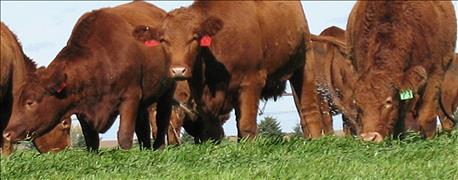December 1, 2016

Dustin Oedekoven, DVM, has a tough job. He’s South Dakota’s state veterinarian and executive secretary of the South Dakota Animal Industry Board. He’s charged with keeping the state’s livestock healthy and safe. He recently answered several questions via email:

PROTECTING LIVESTOCK: Red Angus cattle graze contentedly in a South Dakota pasture, but the possibility of an outbreak of a new or foreign livestock disease is a constant concern for the state veterinarian.
What keeps you up at night? What do you worry about as the state veterinarian?
I’m not much of a worrier. But one thing that my staff and I are continually on alert for is the introduction of foreign, transboundary and emerging animal diseases. Examples of foreign or transboundary diseases would include known pathogens such as foot-and-mouth disease (FMD, also known as hoof-and-mouth disease), classical swine fever or Rift Valley fever. These are viral diseases that are on our radar and for which we have available diagnostic tests, either at the Animal Disease Research and Diagnostic Lab in Brookings, or at the USDA’s Foreign Animal Disease Diagnostic Lab on Plum Island, N.Y. Emerging diseases may not be as high on our radar, and diagnostic tests may or may not be available, depending on the pathogen. New and emerging diseases are an unknown threat.

Dustin Oedekoven
Why do those things worry you?
Domestic and international movement of people, animals and products increases the risk of introduction and rapid dissemination of new or emerging pathogens in animals and people. Recent examples in swine include the introduction of porcine epidemic diarrhea virus (PEDV) and the emergence of Seneca Virus A (SVA). Despite efforts to prepare and plan for response to foreign and emerging animal diseases, knowledge gaps continue to exist. The economic impacts of these diseases are detrimental to the livestock industry, not to mention the related economic impacts to our state.
What would the nation have to do to be more prepared for the things that worry you?
Much has been done for both prevention against and preparation for response to foreign livestock diseases. However, the challenge is to remain vigilant. We need to prioritize our knowledge gaps as well as our resource needs, and plan accordingly to meet them. More investments in surveillance and preparedness for response are needed. A specific example is the inadequacy of our North American FMD Vaccine Bank. If FMD were to be introduced in our livestock populations, vaccination of susceptible species may be considered as part of the response effort. However, the bank does not currently contain actual vaccine that is ready to be distributed and used. It is actually an antigen bank that can be thought of somewhat as a vaccine premix for the most common types of FMD. The antigen bank must be processed into actual vaccine, and unfortunately the supply of vaccine we will be able to manufacture based on our current stores is generally accepted as inadequate if vaccine is to be used for a large-scale, multistate response.
What things can poultry and livestock producers be doing now to guard against the things you are concerned about?
Work with a veterinarian for your animal health needs, get Certificates of Veterinary Inspection when transporting livestock interstate and to livestock or poultry shows. Know purchasing sources and gather as much information about the health of the animals as possible. Practice good biosecurity!
What lessons did we learn from the avian flu epidemic?
Preparedness for FAD response is useful, even if the plans don’t work out exactly as practiced. Diagnostic capacities were overloaded in multiple states as poultry needed to be tested to continue to move interstate. This is an important point as we consider expansion of our South Dakota Veterinary Diagnostic Lab. We must maintain high-quality diagnostic capability. When disease strikes, diagnostic testing is a key component to continuity of our livestock industry.
Response resources can be quickly exhausted. State and federal animal health officials were fortunate to have the cooperation of the poultry industry, private veterinarians and many others who helped get the job done. Working together works!
You May Also Like




